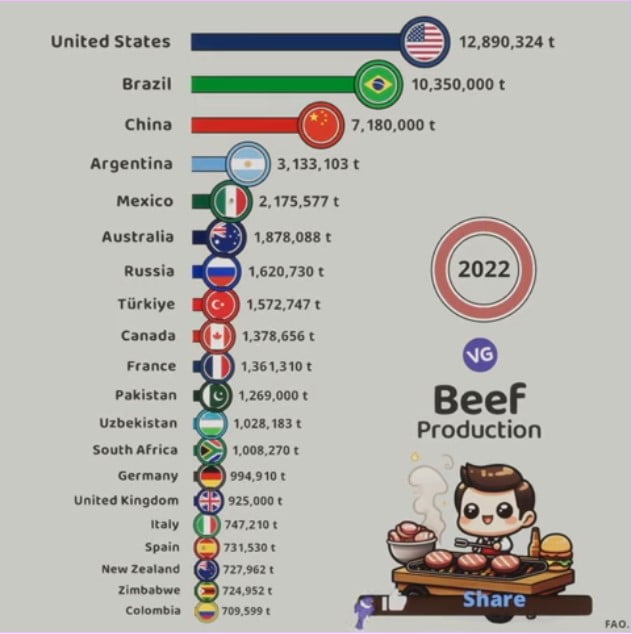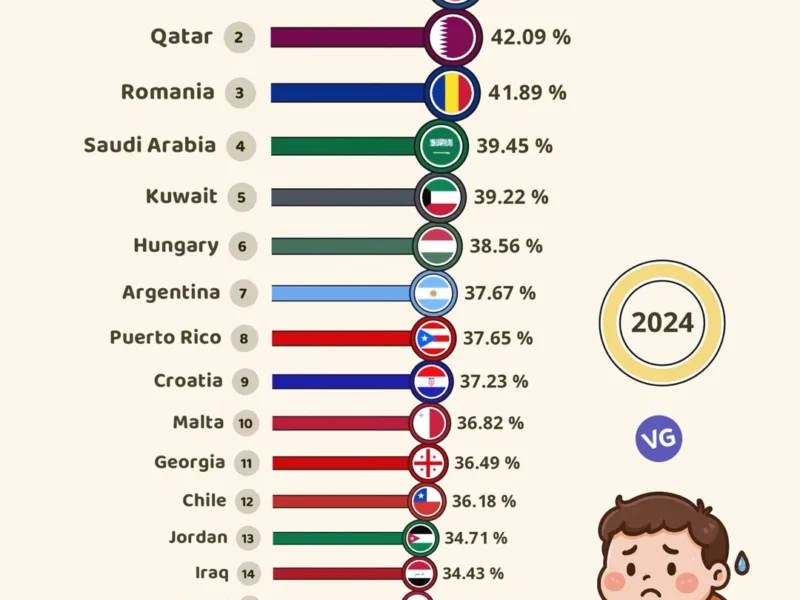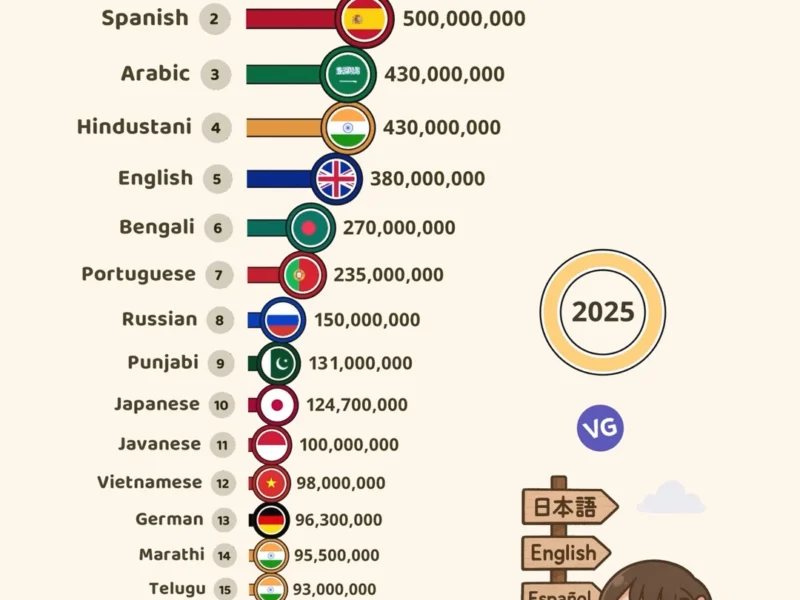The world’s beef scene is always changing, with some countries standing out in production. The United States Department of Agriculture (USDA) tells us about the big beef makers in 2022: the USA, Brazil, China, India, Argentina, Mexico, Australia, France, Canada, and Russia.1 The top three, the USA, Brazil, and China, make more than half of the world’s beef.2 Beef is greatly wanted around the globe for its taste and many uses. So, beef making and selling doesn’t just mean dinner; it’s big for jobs and a country’s economy too.
Key Takeaways
- The United States is the world’s largest beef producer, making more than 12 million metric tons yearly. It’s a hefty 20.44% of global beef making.1
- Brazil comes next, producing 10.35 million metric tons, and has the most cattle overall.2
- China holds the third spot, with 7.18 million metric tons of beef. India, against beef-eating traditions, is fourth, with 4.35 million metric tons.2
- The beef business was worth $332.28 billion in 2022. It’s said to grow to $421.61 billion by 2028, rising at 4.05% a year.3
- Together, the USA, Brazil, and China make over half of all the beef in the world.2
Introduction to Beef Production
The4 beef market is key in global trade, always growing with strong demand. Beef is loved for its taste and how it fits into many cultures’ diets. But it’s not just about the food; beef also boosts economies by creating jobs and boosting trade.
In the U.S., for example, beef farming is a top player in the agricultural economy. About 17 percent of all money made in the farm sector comes from cattle each year. This money matters a lot, supporting farmers and ranchers and feeding people worldwide.
Importance of Beef in Global Trade
The4 United States tops the list as the biggest beef maker, thanks to its huge cattle industry. The industry mainly focuses on raising calves and then fattening them up for market. Interestingly, the U.S. actually imports more beef than it exports, choosing to buy cheaper, grass-fed beef from elsewhere.
This need for imports is expected to grow because the U.S.’s own beef production might go down. Still, many U.S. ranches use a farming method that’s good for the land called rotating grazing.
However, the beef industry is becoming more concentrated in the hands of fewer big companies. This shift raises some concerns about competition in the beef market.
Nutritional Value and Culinary Versatility
Beef is not only tasty but also packed with important nutrients like protein, iron, and zinc.5 Despite its nutritional value, the number of cows in the U.S. has slightly dropped in recent years. Yet, big farms with over 100 cows are still a major player in the market.
When it comes to getting cows ready for sale, most operations are small. But a good chunk of the market is controlled by large farms that handle over 32,000 cows. This setup might affect how beef is produced and sold.
Economic Impact of Beef Production
Beef farming is a heavyweight in the economy, creating jobs and balancing trade for many countries. The U.S. stands out as a major beef seller worldwide, trailing only Brazil in exports.4 Over the years, reports have looked at how U.S. beef and other meat sales impact prices and people’s choices, especially during the recent pandemic.
While beef farming has merged more in the past 30 years, so have the companies that process and sell the meat. These trends have raised concerns about competition and fairness in the marketplace.
Ranking of Top Beef Producing Countries
According to the United States Department of Agriculture (USDA), the top 10 beef producers in 2022 were the USA, Brazil, China, India, Argentina, Mexico, Australia, France, Canada, and Russia.2 Each country produces different amounts and has its own cattle herd sizes. They play important roles in the beef industry worldwide.
| Country | Beef Production (million tons) | Cattle Herd (million heads) |
|---|---|---|
| USA | 12.892 | 92.082 |
| Brazil | 10.352 | 193.782 |
| China | 7.182 | 98.002 |
| India | 4.352 | 306.702 |
| Argentina | 3.142 | 53.402 |
| Mexico | 2.182 | 17.312 |
| Australia | 1.882 | 23.042 |
| France | 1.582 | 17.402 |
| Canada | 1.412 | 11.512 |
| Russia | 1.322 | 17.792 |
The USA, Brazil, and China produce over half of the world’s beef.1 These countries lead in beef production. Their amounts and cattle herds differ, but they are key in the world beef industry.
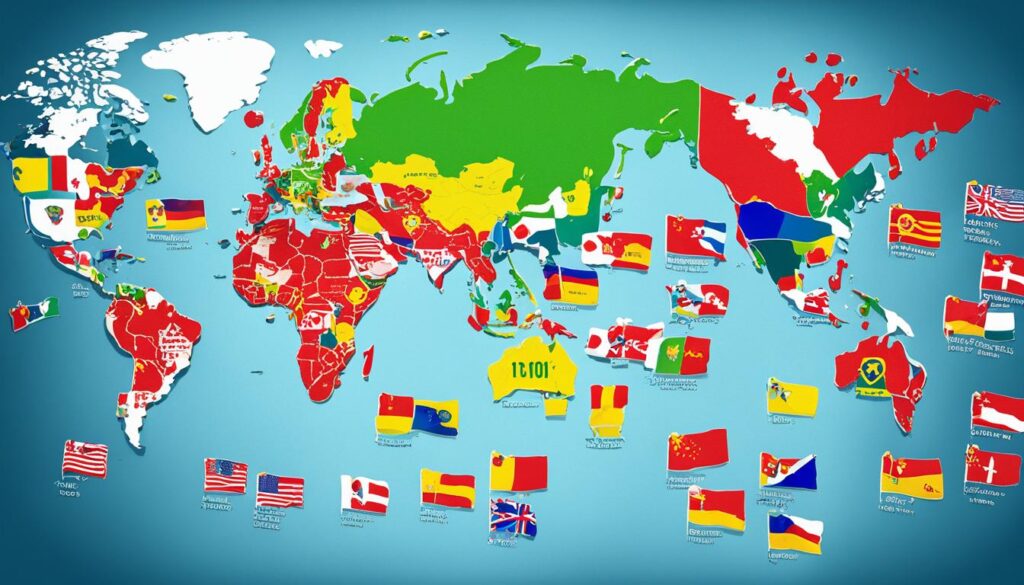
United States: Leading Beef Producer
In 2022, the United States topped the list in beef production with 12.89 million tons. It also boasts a cattle herd of about 92 million heads.2 Efficient beef production, vast natural resources, and advanced technology are key factors. These make the U.S. a powerful player in the global beef industry.2
Production Statistics
Annually, the U.S. churns out 12,379,000 metric tons of beef, claiming a 20.44% share worldwide.1 It’s not only the largest producer but also the biggest consumer. This is seen in the 12.9 thousand metric tons of beef eaten in 2021. That’s about 57 pounds per person.1
Cattle Herd Size
The U.S. holds a massive cattle herd of 92 million. This large herd, together with the nation’s cutting-edge farming methods, keeps the U.S. in the lead.2
They are the top beef producer globally, maintaining this status with ease.2
Supply Chain and Global Presence
Its well-established supply chain and global involvement bolster the U.S.’s position in the beef market.2 Well-known entities such as Tyson Foods, Inc., and JBS USA Holdings, Inc. drive the market. They focus on sustainable practices, animal welfare, and innovative processing.6
Brazil: Second-Largest Beef Producer
Brazil holds the title of the second-largest beef producer worldwide. In 2022, it churned out 10.35 million tons of beef. The country boasts a whopping 193 million cattle.
This achievement is due to Brazil’s vast land, perfect climate, and a focus on tech and good farming methods. As a bonus, Brazil leads as the biggest beef exporter too, all thanks to its top-notch product safety.27
Production Statistics
Back in 2021, Brazil also claimed the second spot in beef production, making 9.7 million tonnes. They did this by processing 39 million cattle. A good part of this beef, 25.5%, was sent overseas, bringing in roughly US$8 billion.8
Their production peak hit 9.9 million metric tons in 2018.7
Cattle Herd Size
Among all nations, Brazil is second only in its cattle count, with 232 million head. Onward from 1990 to 2018, the herd size saw a 56% increase. In the year 2022, there were nearly 194 million cattle in Brazil’s herds.72
Technological Advancements and Agricultural Practices
Brazil owes its farming success to its vast and fertile land, plus a dedication to innovation and pure agricultural methods. This combo not only yields quality and safety in beef but also gives Brazil the global export crown.27
Largest Beef Producers in the World
China: Third-Largest Producer
China ranks as the globe’s third-biggest beef maker. It produced 7.18 million tons in 2022. This comes from a herd of over 98 million cattle.2 It tops the charts for beef consumption, yet its own beef-making is on the rise.
India: Surprising Fourth-Largest Producer
India stands out as the world’s fourth-largest beef producer, a surprise for many. It generated 4.35 million tons last year. It does this with a herd of around 306 million cattle.2 Even though the country’s mostly Hindu population holds cows as sacred, its large population and technological advancements explain its prominent role in the beef market.
Argentina: Fifth-Largest Beef Producer
Argentina takes the fifth spot with its 3.14 million tons of beef in 2022. It has a sizeable herd of more than 53 million cattle. Known for efficient and eco-friendly processes, it stands strong as a key beef producer globally.2
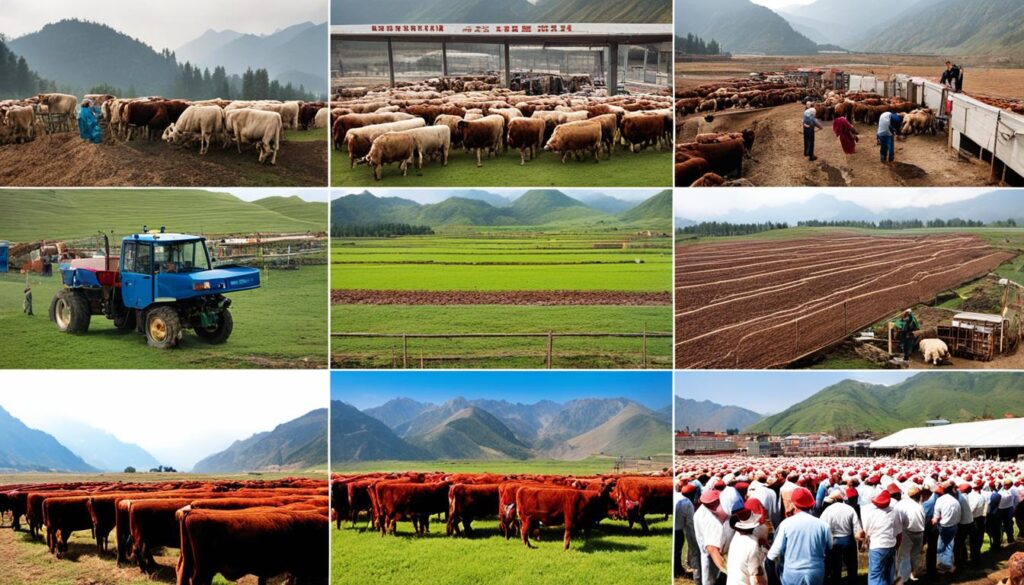
Other Major Beef Producing Countries
Besides the top five producers, other nations are major players in beef. Mexico is the world’s sixth-largest beef producer. It makes 2.18 million tons annually from 17 million cattle.
Australia comes next, producing 1.88 million tons with 24 million cattle. It’s known for its large grasslands and modern farming.
France is eighth, with 1.58 million tons from a herd of almost 18 million. It’s a key beef producer in Europe.
Then there’s Canada, ninth, making 1.41 million tons from over 11 million cattle. Its beef industry is growing fast. Finally, Russia produces 1.32 million tons using 18 million cattle. It’s working on new tech to boost beef output.
Mexico
Mexico is the world’s sixth-largest beef maker. It produces 2.07 million tons yearly, supplying 3.43% of the world’s beef.1 It has about 17.31 million cattle, helping meet its beef demand.2
Australia
Australia ranks seventh, making 2.12 million tons a year. This is 3.50% of the global supply.1 It boasts 23.04 million cattle. Australia is a big beef exporter known for its quality.2
France
In eighth place is France, with 1.58 million tons yearly. It has 17.4 million cattle.2 France focuses on raising animals in wide, open spaces. This helps it stand out in Europe’s beef market.
Canada
Canada comes in ninth, making 1.31 million tons each year. That’s 2.16% of the world’s beef supply.1 Canada is very focused on the quality and safety of its beef. It has 11.51 million cattle.2
Russia
Finally, Russia is tenth with 1.37 million tons annually. This is 2.27% of all beef made..1 It has almost 17.79 million cattle. Russia is putting a lot of effort into new technology for beef production.2
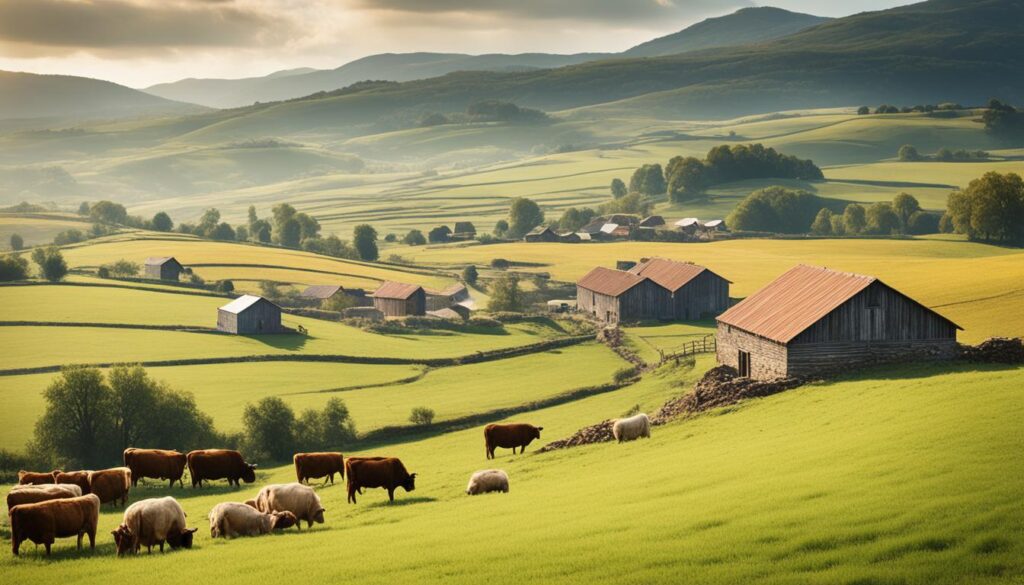
Global Beef Demand and Consumption Trends
The world’s appetite for beef has grown a lot in the past 50 years. Meat production has more than tripled during this time.9 Currently, over 340 million tons of beef are produced every year.10 This boost in demand comes from more people, higher incomes, and changing food choices.10
With more people on the planet and economies growing, the need for protein, like beef, remains high. This brings both good chances and tough challenges for those in the beef business.10 In 2023, the global beef market was worth USD 436.60 billion. It’s predicted to jump to USD 656.44 billion by 2032, with a 5.52% growth every year.10 Also, the ability of folks in places like China and Thailand to buy more is pushing up meat demand.10
The beef sector, however, has its hurdles. More folks are learning about the dangers of eating too much fat, which is slowing sales in developed places.10 Moreover, people are preferring beef that’s natural and free of antibiotics.10
Yet, even with these issues, the beef market is growing. This growth is thanks to the push for top-quality beef, more informed consumers, and better ways to sell, like online platforms and stores.10
Sustainable Beef Production Practices
The beef industry is working hard to be more eco-friendly. It’s important because beef’s effect on the environment is significant. This includes things like greenhouse gases, how much land it needs, and water use.11 Almost one-third of all the water used in farming comes from beef alone.11 It’s also vital to treat the cows well, and people care about this more and more.
Environmental Impact
Many beef producers are now focusing on being greener. They are using new technologies and better ways of managing the land. This is to lower their overall impact on the planet.11 Each year, about 60 million metric tons of beef are made worldwide.11 With these new approaches, beef production is trying to keep up with what customers want.11 Because of concerns about the environment, plant-based and lab-grown meats are getting more popular. They are expected to grow a lot in the coming years.11
Animal Welfare Considerations
How cattle are treated matters a lot in the push for sustainable beef. The Global Roundtable on Sustainable Beef is set up to look at the whole industry’s impact. This includes the planet, communities, and the well-being of the cows.11 Understanding and meeting everyone’s needs in the beef world is a real challenge. It’s a global business with many different players.11 The roundtable is getting ready to share a way to track and report on making beef production better.11
12 Brazil is key in all this, with over 224 million cows. It leads the world in beef exports.12 The industry there is huge, taking up an area as big as France and Italy combined.12 Beefing up practices could mean less harm to the planet and more meat to go around.12 Also, there’s a lot of money to be made by making cattle farming greener in Brazil.12
11 Big companies like Walmart and McDonald’s want to use less water and land in their beef. They are also looking at ways to please their investors and the public.11 Improving how cows graze can be a big step towards being kinder to the earth.11
Conclusion
The United States, Brazil, and China lead beef production worldwide. They make up about 51% of the beef we eat. These countries, with others in the top 10, have strong cattle industries and a big part in the global beef market.213
Beef is key in the world’s food system, providing nutrition and jobs. But, it does meet with challenges like making sure it’s good for the earth, caring for animals, and staying sustainable. These issues are tackled with new ways and tech.
The need for beef keeps rising. Top producers are vital in meeting this need while caring for the industry’s future. The biggest beef-making countries and their ways of trading will shape how things go in the beef world.13
FAQ
What are the 10 largest beef producers in the world?
The United States Department of Agriculture (USDA) lists the top beef producers for 2022. The list includes countries like the USA, Brazil, China, and India. It also features Argentina, Mexico, Australia, France, Canada, and Russia.
Which countries account for the majority of global beef production?
Around 51% of the world’s beef comes from the USA, Brazil, and China.
What is the economic impact of beef production?
Beef production and export make a big economic difference. It provides jobs for people worldwide. Plus, it helps the trading profits of many countries.
What are the key factors driving the growth in global beef demand?
There’s been more demand for beef globally. This is due to more people, higher incomes, and changing diets.
What are the challenges facing the modern beef industry?
Challenges for the beef industry include becoming more sustainable. They also need to tackle their impact on the environment. Ensuring cattle are treated well is another big challenge.
Source Links
- https://www.meatloaf.pro/the-40-countries-that-produce-the-most-beef/
- https://ruminants.ceva.pro/beef-producing-countries
- https://finance.yahoo.com/news/25-biggest-beef-producing-countries-073009191.html
- https://www.ers.usda.gov/topics/animal-products/cattle-beef/
- https://www.ers.usda.gov/topics/animal-products/cattle-beef/sector-at-a-glance/
- https://essfeed.com/top-10-beef-producers-in-the-usa/
- https://www.ers.usda.gov/amber-waves/2019/july/brazil-once-again-becomes-the-world-s-largest-beef-exporter/
- https://www.sei.org/features/trase-brazil-beef-exports-deforestation/
- https://ourworldindata.org/meat-production
- https://www.fortunebusinessinsights.com/beef-market-106640
- https://www.greenbiz.com/article/down-farm-beef-industry-inches-toward-sustainability
- https://thepalladiumgroup.com/news/Sustainable-Beef-is-Possible-Says-New-Report-from-Palladiums-Partnerships-for-Forests
- https://essfeed.com/worlds-top-10-largest-beef-producing-countries/

